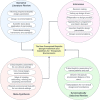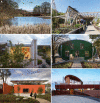Human-centred health-care environments: a new framework for biophilic design
- PMID: 37560462
- PMCID: PMC10408300
- DOI: 10.3389/fmedt.2023.1219897
Human-centred health-care environments: a new framework for biophilic design
Abstract
Increasing research corroborates that the qualities of the setting in which a patient receives healthcare positively influence health outcomes. Therefore, it has become progressively important to review the concept of therapeutic environments, as places where patients are treated with the most advanced medicine and technology, but also support their users in psychological, emotional and social terms. This quest for the optimal healing environment brings to the forefront the need to include other parameters in our design briefs, where the application of biophilic design proves to be paramount, as exposure to nature is associated with multiple health benefits. However, current biophilic design frameworks fail to provide efficient guidance, as their design recommendations don't differentiate the level of value of each design parameter for each building programme and context. Our position is that a biophilic design framework can only be efficient if it is adapted to specific building functions and is geographically and culturally contextualized. This study assessed the application of biophilic design in therapeutic environments for cancer patients in the UK, and provided a revised conceptual framework that can more efficiently guide designers and policies in future interventions. This framework was informed by synthesised analyses from healthcare environments on the user's experiences, and primary data obtained from semi-structured interviews with architects and managers, which was then benchmarked against scientific data about the impact of biophilic design on humans. This comprehensive approach helped to identify and rank those biophilic design parameters that appear the most critical for promoting and supporting health and wellbeing in cancer healthcare settings and provided an up-to-date compilation of crucial design actions to enact the necessary change in future research and design practice.
Keywords: biophilic design; cancer; nature; non-clinical environment; therapeutic environment.
© 2023 Tekin and Urbano Gutiérrez.
Conflict of interest statement
The authors declare that the research was conducted in the absence of any commercial or financial relationships that could be construed as a potential conflict of interest.
Figures








Similar articles
-
A Systematic Review and Conceptual Framework of Biophilic Design Parameters in Clinical Environments.HERD. 2023 Jan;16(1):233-250. doi: 10.1177/19375867221118675. Epub 2022 Aug 22. HERD. 2023. PMID: 35996349 Free PMC article. Review.
-
Biophilic Experience-Based Residential Hybrid Framework.Int J Environ Res Public Health. 2022 Jul 12;19(14):8512. doi: 10.3390/ijerph19148512. Int J Environ Res Public Health. 2022. PMID: 35886362 Free PMC article.
-
The healing power of nature. Biophilic design applied to healthcare facilities.Curr Opin Psychol. 2025 Aug;64:102049. doi: 10.1016/j.copsyc.2025.102049. Epub 2025 May 12. Curr Opin Psychol. 2025. PMID: 40414183 Review.
-
Biophilic Design as an Important Bridge for Sustainable Interaction between Humans and the Environment: Based on Practice in Chinese Healthcare Space.Comput Math Methods Med. 2022 Jul 6;2022:8184534. doi: 10.1155/2022/8184534. eCollection 2022. Comput Math Methods Med. 2022. PMID: 35818624 Free PMC article.
-
Biophilic Design and Its Effectiveness in Creating Emotional Well-Being, Green Satisfaction, and Workplace Attachment Among Healthcare Professionals: The Hospice Context.HERD. 2024 Jan;17(1):190-208. doi: 10.1177/19375867231192087. Epub 2023 Aug 22. HERD. 2024. PMID: 37606216
Cited by
-
Home Environment as a Therapeutic Target for Prevention and Treatment of Chronic Diseases: Delivering Restorative Living Spaces, Patient Education and Self-Care by Bridging Biophilic Design, E-Commerce and Digital Health Technologies.Int J Environ Res Public Health. 2025 Feb 5;22(2):225. doi: 10.3390/ijerph22020225. Int J Environ Res Public Health. 2025. PMID: 40003451 Free PMC article.
-
Biophilic design, neuroarchitecture and therapeutic home environments: harnessing medicinal properties of intentionally-designed spaces to enhance digital health outcomes.Front Med (Lausanne). 2025 Jul 10;12:1610259. doi: 10.3389/fmed.2025.1610259. eCollection 2025. Front Med (Lausanne). 2025. PMID: 40708654 Free PMC article.
References
LinkOut - more resources
Full Text Sources

